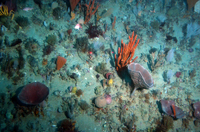Marine treasures of Tasmania's Flinders Island
20 June 2014

Sponge and bryozoan garden covering
an area of reef in Flinders Commonwealth
Marine Reserve; water depth 38 metres.
Image credit: Institute for Marine and Antarctic
Studies (University of Tasmania) and CSIRO.
Marine geoscientists have gained an amazing underwater view of the Flinders Commonwealth Marine Reserve, located off northeast Tasmania.
The region is recognised as an important area for a range of marine life, including diverse sponge gardens that grow on rocky reefs, sea birds including albatrosses; and is also on the known migration route for humpback whales.
Geoscience Australia marine scientist Dr Scott Nichol said the Flinders Marine Reserve was chosen as a survey area as it includes a variety of shallow seabed environments including reefs, sandy plains and the heads of submarine canyons.
The high resolution sonar, and underwater video footage obtained by an underwater camera, show that the reef in this area is patchy and mostly flat. This contrasts with the much steeper reefs previously mapped by Geoscience Australia off Tasmania's southeast coast.
Despite the flatness of the reefs, they form a stable surface for sponge gardens that in turn provide habitat for a range of other marine life including diverse fish communities.
"In the deeper waters of the canyon heads, the team recorded large schools of Tasmanian striped trumpeter and sharks; and researchers were even lucky enough to catch a glimpse of an orca whale," Dr Nichol added.
The survey was undertaken in mid-2012 on board RV Challenger, about 50 kilometres south east of Flinders Island in an area that extends to the edge of the continental shelf. The information gathered is now being used by the Australian Government to support ongoing management and monitoring of the unique habitats and biological communities within the Flinders Commonwealth Marine Reserve.
This survey is one of a series of seabed mapping projects in targeted areas of Australia's Commonwealth marine territory being undertaken by Marine Biodiversity Hub as part of the National Environmental Research Program.
A short video, which can be viewed via Geoscience Australia's YouTube channel, gives an overview of the insights that the Flinders Marine Reserve survey has given us.




